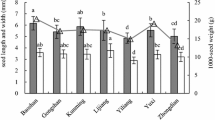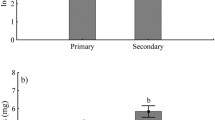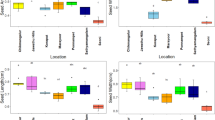Summary
To determine the role of seed size in creating adult plants of different reproductive success, individual seedlings were marked and periodically censused in a natural stand of wild radish (Raphanus raphanistrum L.) in Hamden, Connecticut. Maximum cotyledon witdth is a useful field estimator of seed weight in this species, although dramatic variation in the availability of water can modify this relationship. Using maximum cotyledon width as a linear estimate of seed weight showed that an increase in seed weight gives rise to a disproportionately large increase in an individual's total reproductive output. Analysis of covariance demonstrated that reproductive output is influenced more heavily by seed weight (maximum cotyledon width) than by emergence time. Genetic variation for seed size has been maintained in this population, suggesting that selection favoring large seeds during the seedling stage may be counteracted by selection for large numbers of seeds.
Similar content being viewed by others
References
Abul-Fatih HA, Bazzazz FA (1979) The biology ofAmbrosia trifida. L. II. Germination, emergence, growth, and survival. New Phytol 83:817–827
Beveridge JL, Wilsie CP (1959) Influence of depth of planting, seed size, and variety on emergence and seedling vigour in alfalfa. Agron J 51:731–734
Black JN (1956) The influence of seed size and depth of sowing on preemergence and vegetative growth of subterranean clover (Trifolium subterraneum L.). Austr J Agr Res 7:98–109
Black JN (1958) Competition between plants of different initial seed sizes in swards of subterranean clover (Trifolium subteraneum L.) with particular reference to leaf area and the light microclimate. Austr J Agr Res 9:299–318
Capinera JL (1979) Qualitative variation in plants and insects: effect of propagule size on ecological plasticity. Am Natur 114:350–361
Cook RE (1979) Patterns of juvenile mortality and recruitment in plants. In: OT Solbrig, S Jain, G Johnson, PH Raven (eds). Topics in plant population biology, Columbia University Press, NY, pp 207–231
Cook RE, Lyons EE (1983) The biology ofViola fimbriatula in a natural disturbance. Ecology 64:654–660
Erickson LC (1946) The effect of alfalfa seed size and depth of seeding upon the subsequent procurement of stand. J Amer Soc Agron 38:964–973
Ford ED (1975) Competition and stand structure in some evenaged plant monocultures. J Ecol 63:311–333
Freund RJ, Littell RC (1981) SAS for linear models. SAS Institute, Cary, NC, USA
Gottlieb LD (1977) Genotypic similarly of large and small individuals in a natural population of the annual plantStephanomeria exigua ssp.coronaria (Compositae). J Ecol 65:127–134
Gross K (1981) Predictions of fate from rosette size in four biennial plant species —Verbascum thapsus, Oenothera biennis, Daucus carota, andTragopogon dubius. Oecologia (Berlin) 48:209–213
Harper JL, Lovell PH, Moore KG (1970) The shapes and sizes of seeds. Ann Rev Ecol Syst 1:327–356
Harper JL, Obeid M (1967) Influence of seed size and depth of sowing on the establishment and growth of varieties of fiber and oil seed flax. Crop Sci 7:527–532
Harper JL, White J (1974) The demography of plants. Ann Rev Ecol Syst 5:419–463
Holm L, Pancho JV, Herberger JP, Plucknett DL (1979) A Geographical Atlas of World Weeds. Wiley, NY
Howe HF, Richter WM (1982) Effects of seed size on seedling size inVirola surinamensis: a within a between tree analysis. Oecologia (Berlin) 53:347–351
Howell N (1981) The effect of seed size and relative emergence time on fitness in a natural population ofImpatients capensis Meerb. (Balsaminaceae). Am Midl Natur 105:312–320
Janzen DH (1977) Variation in seed size within a crop of Costa RicanMucuna andreana (Leguminosae). Am J Bot 64:347–349
Janzen DH (1982) Variation in average seed size and fruit seediness in a fruit crop of a Guanacaste tree (Leguminosae:Enterolobium cyclocarpum). Am J Bot 69:1169–1178
Kay QON (1976) Preferential pollination of yellow-flowered morphs ofRaphanus raphanistrum byPieris andEristalis spp. Nature (Lond) 261:230–232
Obeid M, Machin D, Harper JL (1967) Influence of density on plant to plant variation in fiber flax,Linum usitatissimum L. Crop Sci 7:471–473
Roberts HA, Feast PM (1972) Emergence and longevity of seeds of annual weeds in cultivated and undisturbed soil. J Appl Ecol 10:133–143
Ross MA, Harper JL (1972) Occupation of biological space during seedling establishment. J Ecol 60:77–88
Sampson DR (1964) A one locus self-incompatibility system inRaphanus raphanistrum. Can J Genet Cytol 6:435–445
Smith CC, Fretwell SD (1974) The optimal balance between size and number of offspring. Am Natur 108:499–506
Solbrig OT (1981) Studies on the population biology of the genusViola. II. The effect of plant size on fitness ofViola sororia. Evolution 35:1080–1093
Stanton ML (1984a) Seed variation in wild radish: effect of seed size on components of seedling and adult fitness. Ecology 65:1105–1112
Stanton ML (1984b) Developmental and genetic sources of seed weight variation inRaphanus raphanistrum L. (Brassicaceae). Am J Bot 71:1090–1098
Thompson JN (1984) Variation among individual seed masses inLomatium grayi (Umbelliferae) under controlled conditions: magnitude and partitioning of the variance. Ecology 65:626–631
Turner MD, Rabinowitz D (1983) Factors affecting frequency distributions of plant mass: the absence of dominance and suppression in competing monocultures ofFestuca paradoxa. Ecology 64:469–475
Waller DM (1982) Factors influencing seed weight inImpatiens capensis (Balsaminaceae). Am J Bot 69:1470–1475
Weaver SE, Cavers PB (1979) Dynamics of seed populations ofRumex crispus andRumex obtusifolius (Polygonaceae) in disturbed and undisturbed soil. J Appl Ecol 16:909–917
Weaver SE, Cavers PB (1980) Reproductive effort of two perennial weed species in different habitats. J Appl Ecol 17:505–513
Werner PA (1975) Predictions of fate from rosette size in teasel (Dipsacus fullonum L.). 20:197–201
Author information
Authors and Affiliations
Rights and permissions
About this article
Cite this article
Stanton, M.L. Seed size and emergence time within a stand of wild radish (Raphanus raphanistrum L.): the establishment of a fitness hierarchy. Oecologia 67, 524–531 (1985). https://doi.org/10.1007/BF00790024
Received:
Issue Date:
DOI: https://doi.org/10.1007/BF00790024




